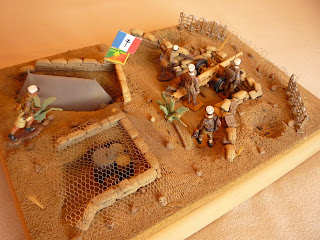The War of the Pacific was a conflict between Chile against Bolivia and Peru from 1879 to 1883. Also known as the Saltpetre or Nitrate War, because it was caused by the disputes over the control of territory containing rich deposits.
A short Naval Campaign, won by the Chilean Navy, was followed by a Land Campaign developed in a series of victories for the Chilean army commanded by General Manuel Baquedano.
After the battle of Tacna on May 26 1880, General Baquedano commissioned Captain Juan Dinator from Carabineros de Yungay Horse Squadron to head to Arica (60 km South) in order to reconnoitre the area.
Captain Dinator with 50 cavaliers led by the 2nd Lieutenant Manuel Fornes Garcia followed the rail tracks from the railway Tacna-Arica-Tacna to a km before Hospicio Station, there Dinator and 3 other men took a hand trolley and headed cautiously to the small station. Fornes and the other 47 troops stayed at rearguard on alert.
The combat began again for a few minutes but finally the Peruvians soldiers had withdrawn. The Chilean section stayed in the Hospicio station until dawn. Next day they progressed to the next railway station, Chacalluta. On June 7 1880, the Chilean Army conquered Arica and the war finished on October 20 1883
* * *
La Guerra del Pacífico fue un conflicto entre Chile, Perú y Bolivia desde 1879 hasta 1883. Es también conocida como la Guerra del Salitre ya que fue causada por la disputa del control sobre los ricos territorios conteniendo este mineral.
A una corta campaña naval, que le dió a Chile la supremacía marítima, le siguieron varias campañas terrestres con una serie de victorias para el Ejército chileno comandado por el General Manuel Baquedano.
Luego de la Batalla de Tacna el 26 de Mayo de 1880, el General Baquedano ordenó al capitán Juan Dinator, del Regimiento de Caballería "Carabineros de Yungay", dirigirse hacia Arica (60 km. al Sur) con el objeto de reconocer el área. Al anochecer, el Capitán Dinator y el 2º Teniente Manuel Fornes García a la cabeza de 50 jinetes siguieron la línea del tren que une Tacna y Arica hasta 1 km. antes de llegar a la Estación Hospicio. Allí Dinator con 3 hombres abordaron un trolley manual y se dirigieron hacia la estación. Fornes con el resto de la tropa quedó en retaguardia.
Dinator y su escolta avanzaban bajo el manto de la noche cuando fueron descubiertos por una vanguardia peruana de los "Tiradores de Lluta" que les dieron el ¡Alto! pero Dinator y sus hombres prosiguieron su avance. Los soldados peruanos abrieron fuego que fue respondido por los chilenos.
Fornes, al escuchar el tiroteo, avanzó y también abrió fuego dispersando la vanguardia de los "Tiradores de Lluta". Al mismo tiempo se hizo presente un escuadrón peruano con 50 jinetes y tropa de infantería. El combate se reanudó durante algunos minutos hasta que las fuerzas peruanas se replegaron hacia Arica.
La sección chilena permaneció en Hospicio hasta el amanacer. Al otro día avanzaron hasta la siguiente estación, Chacalluta.
El 7 de Junio el Ejército chileno ocupó Arica luego de una feroz pero corta batalla.
La guerra terminó el 20 Octubre de 1883.
EL DIORAMA
Como los precedentes dioramas presentados, esté fue realizado con figuras de diversos fabricantes que fueron transformadas y adaptadas para este objeto.
El paisaje y algunos elementos de la escena fueron confeccionados por mi.





































